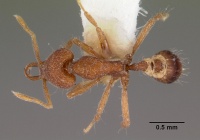Strumigenys paraposta
| Strumigenys paraposta | |
|---|---|

| |
| Scientific classification | |
| Kingdom: | Animalia |
| Phylum: | Arthropoda |
| Class: | Insecta |
| Order: | Hymenoptera |
| Family: | Formicidae |
| Subfamily: | Myrmicinae |
| Tribe: | Attini |
| Genus: | Strumigenys |
| Species: | S. paraposta |
| Binomial name | |
| Strumigenys paraposta Bolton, 2000 | |
Nothing is known about the biology of Strumigenys paraposta.
Identification
Bolton (2000) - A member of the caniophanes complex in the Strumigenys caniophanes-group. See notes under Strumigenys dipsas.
Keys including this Species
Distribution
Distribution based on Regional Taxon Lists
Oriental Region: Thailand (type locality).
Distribution based on AntMaps
Distribution based on AntWeb specimens
Check data from AntWeb
Countries Occupied
| Number of countries occupied by this species based on AntWiki Regional Taxon Lists. In general, fewer countries occupied indicates a narrower range, while more countries indicates a more widespread species. |

|
Estimated Abundance
| Relative abundance based on number of AntMaps records per species (this species within the purple bar). Fewer records (to the left) indicates a less abundant/encountered species while more records (to the right) indicates more abundant/encountered species. |

|
Biology
Castes
Nomenclature
The following information is derived from Barry Bolton's Online Catalogue of the Ants of the World.
- paraposta. Strumigenys paraposta Bolton, 2000: 763 (w.) THAILAND.
Unless otherwise noted the text for the remainder of this section is reported from the publication that includes the original description.
Description
Worker
Holotype. TL 2.9, HL 0.78, HW 0.54, CI 69, ML 0.35, MI 45, SL 0.41, SI 76, PW 0.34, AL 0.80. Mandible with a small preapical tooth, located close to the apicodorsal tooth. Dorsolateral margin of head in full-face view with at 4-5 freely laterally projecting flagellate hairs: one at level of eye, one just behind level of eye, one in apicoscrobal position, 1-2 posterior to this. Cephalic dorsum with a transverse row of erect flagellate hairs along occipital margin but without erect hairs anterior to this. Dorsum of head finely and densely reticulate-rugulose, spaces between rugulae feebly punctate. Apical funicular segment moderately constricted basally. Pronotal dorsum and side irregularly, but predominantly longitudinally, finely rugulose. Katepisternum mostly smooth but remainder of side weakly punctulate and with vestiges of longitudinal costulae. Anterior coxae finely transversely costulate. Pronotal humeral hair flagellate and very long. Dorsal alitrunk with numerous erect flagellate hairs, at least 4 pairs present on mesonotum. First gastral tergite with numerous long fine flagellate hairs. Dorsal and ventral surfaces of hind femur with spaced rows of standing hairs; dorsal (outer) surfaces of hind tibia and basitarsus each with long erect freely projecting filiform or flagellate hairs. Propodeal teeth short, triangular and acute. Petiole in profile claviform.
Paratypes. TL 2.9-3.0, HL 0.78-0.79, HW 0.54-0.56, CI 69-71, ML 0.34-0.36, MI 43-46, SL 0.41-0.42, SI 73-78, PW 0.34-0.35, AL 0.80-0.85 (3 measured).
Type Material
Holotype worker, Thailand: Doi Inthanon, 6.xi.1985, no. 13 (Lobl & Burckhardt) (Musee d'Histoire Naturelle Genève).
Paratypes. 11 workers with same data as holotype (MHNG, The Natural History Museum).
References
- Bolton, B. 2000. The ant tribe Dacetini. Memoirs of the American Entomological Institute. 65:1-1028. (page 763, worker described)
- Khachonpisitsak, S., Yamane, S., Sriwichai, P., Jaitrong, W. 2020. An updated checklist of the ants of Thailand (Hymenoptera, Formicidae). ZooKeys 998, 1–182 (doi:10.3897/zookeys.998.54902).
- Tang, K. L., Guénard, B. 2023. Further additions to the knowledge of Strumigenys (Formicidae: Myrmicinae) within South East Asia, with the descriptions of 20 new species. European Journal of Taxonomy 907, 1–144 (doi:10.5852/ejt.2023.907.2327).
References based on Global Ant Biodiversity Informatics
- Fontanilla A. M., A. Nakamura, Z. Xu, M. Cao, R. L. Kitching, Y. Tang, and C. J. Burwell. 2019. Taxonomic and functional ant diversity along tropical, subtropical, and subalpine elevational transects in southwest China. Insects 10, 128; doi:10.3390/insects10050128

